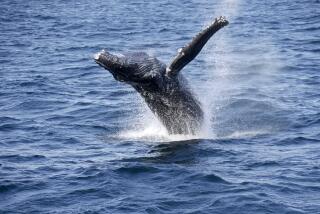Review: ‘The Loneliest Whale’s’ song resonates in the 21st century

The Times is committed to reviewing theatrical film releases during the COVID-19 pandemic. Because moviegoing carries risks during this time, we remind readers to follow health and safety guidelines as outlined by the Centers for Disease Control and Prevention and local health officials.
“The Loneliest Whale: The Search for 52” is not your average nature documentary. In the hands of Joshua Zeman, who has tackled urban legends and serial killers in his work (“Cropsey,” “The Killing Season”), this film is a nature mystery, an unanswered question that needs to be solved. Zeman sets out to answer this question despite unbelievable odds, and like most incredible explorations into the deep, the journey is surprising, though not without reward.
As with many mysteries, this one starts with a news item that caught Zeman’s eye. In 1989, an underwater sonar system developed and used by the Navy captured the biological sonic signature of a whale registering at 52 hertz of frequency, which is unlike any other whale song. In 2004, after the death of Bill Watkins, one of the lead scientists working on tracking this whale, a paper was published that brought this curious creature to the attention of the public. Knowing only that its calls didn’t register with other whales, writers speculated that this one was roaming the seas without response. And thus, “The Loneliest Whale,” a.k.a. “52,” was born, at least in the human imagination.
52 indeed captured the collective unconscious, becoming something of a metaphor or meme for the internet generation, those feeling disconnected the more and more we connected online. Behind computer screens, aren’t we all lonely whales, sending out our unique signatures, hoping someone might hear them and maybe even respond? “The Loneliest Whale” is a “big mood,” as some might say.
The documentary is a chronicle of Zeman’s seemingly impossible journey to find his white whale. With a little data and a whole lot of hope, Zeman sets sail for the Channel Islands off California with a team of oceanographers and biologists in tow, using Navy sonar equipment, drone cameras and tracking tags to try and find 52.
Zeman doesn’t just offer a depiction of his quest but also examines what whales have meant to humans throughout history, how that’s changed and why. In the 20th century, whales evolved in our imaginations from a source of fuel into conscious creatures with whom we could empathize. And there’s so much more to learn from interacting with whales, speaking to our own existential questions. Zeman finds that the key is to really listen and locate the quiet places where messages can come through.
If there’s an environmental message in “The Loneliest Whale: The Search for 52” (how can there not be?), it’s that our world has become too noisy for whales. As container ships crisscross the oceans carrying our cars and clothes and consumer goods, the songs of whales are being drowned out beneath the surface. There’s both devastation and resonance to that fact. Has our own world become too clogged with noise for us to truly hear one another?
Zeman’s voyage into the heart of the sea, a modern day “Moby-Dick” with a conservationist bent, surprises, delights and will keep you on the edge of your seat. You’ll never again think of whales and their songs in the same way, and that’s a good thing, as our understanding of these amazing creatures rapidly evolves.
Katie Walsh is a Tribune News Service film critic.
‘The Loneliest Whale: The Search for 52’
Running time: 1 hour, 30 minutes
Rated: PG, for some unsettling whaling images, language and brief smoking
Playing: Starts July 9 in limited release; available July 16 on digital and VOD
More to Read
Only good movies
Get the Indie Focus newsletter, Mark Olsen's weekly guide to the world of cinema.
You may occasionally receive promotional content from the Los Angeles Times.










